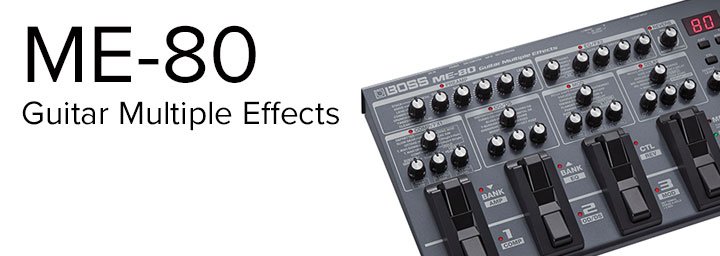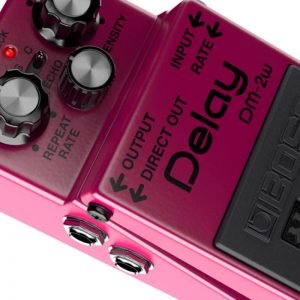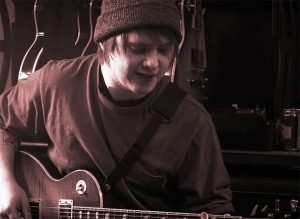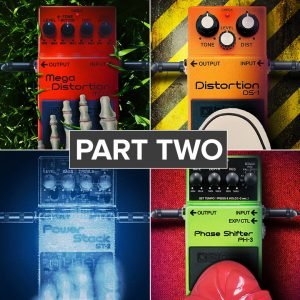So you’re a beginner electric guitar player, you’ve found a guitar and an amplifier that you like. They sound great together but now you really want to wail like David Gilmour, play with delay like The Edge or dream up your own signature tone. Just your guitar and amp won’t cut it; the next step is to explore effects.
There is a huge range of effects available in all shapes and sizes. Many guitarists jump in by buying compact pedals such as the DS-1 distortion or CE-2W chorus, which do one type of effect very well. Another way of entering the world of effects is with a multi effects pedal like the GT-1, which contains a wide variety of effects onboard. However, this approach requires menu diving and preset building. If you’re just beginning your journey with guitar effects and either of these routes sounds a bit daunting to you, then the ME-80 might hit the right spot!
Enter the ME-80
The ME-80 is the perfect introduction to guitar effects for two reasons:
- It has a hands-on, “what you see is what you get” approach – no menu diving required!
- It contains a wide variety of effects to give you a “taster” of almost everything under the sun
Let’s go deeper on these two key reasons.
What You See = What You Get
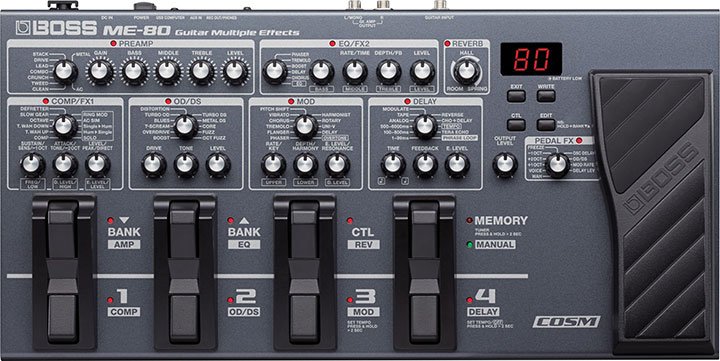

Let’s take a look at the images of the ME-80 vs GT-1 and compare them. What’s the first thing that jumps out? That’s right – the ME-80 is covered in control knobs and labels, whereas the GT-1 is more minimalist in its interface due to its much more compact size and menu-based operation.
This means that as a beginner, with the ME-80 you’ll immediately be able to see what effect you’re on, and what parameters you can control for that effect, while on the GT-1 it might take a few more button presses, and you might not even realise what parameters you can tweak for any given effect if you don’t delve deeper!
That being said, once you’ve dialled in your effects using the straightforward controls on the panel, you do actually have the option of saving up to 36 preset patches on the ME-80. Or, you can continue to use it as a “pedalboard” and just make changes as needed!
Your Virtual Signal Chain
One of the potentially daunting things about getting into single pedals is the question of how to arrange your signal chain.
The ME-80 makes things easy for you by pre-arranging the 8 onboard effects groups into a set signal chain, which aims to:
- keep noise to a minimum.
- achieve the most tonal flexibility.
- produce tone in the most natural, organic way
Let’s take a look at how you could assemble your “virtual pedalboard” with the ME-80’s huge selection of effects, and while we’re at it, learn a bit about why the signal chain is configured the way it is.

 PEDAL FX
PEDAL FX
The first effect in our signal chain is a pedal wah. A wah is an effect known as a filter that alters the basic tone of the guitar. When you push the pedal fully forward, the filter brightens up your guitar tone and you bring back the pedal your guitar tone gets darker. For the most variety of sound, you want all the other effects to have a shot at the sound from the Wah so the ME-80 places it as close to the guitar as possible.  COMPRESSOR
COMPRESSOR
After the wah, we have a compressor. A compressor improves the sustain available to your guitar by increasing the overall volume of any signal you feed into it. At the same time it helps to soften out any big volume spikes by clamping down the volume if it gets too loud. The ME-80 puts the compressor close to your guitar because any other effect placed before the compressor will be boosted in volume which will make the effect a lot harder to control.  OVERDRIVE/DISTORTION
OVERDRIVE/DISTORTION
Overdrive and distortion are effects that introduce harmonics to your guitar tone by pushing more volume into a circuit until it can’t handle it anymore and starts to break up. The types of sounds you can get from an overdrive or distortion range from a light boost to a full on metal crunch. Overdrive and distortion effects are great when placed after a compressor but before any of your other effects. PREAMPLIFIER
In a compact pedal set up the next step would be to plug these effects directly into the input of your guitar amp. However, the ME-80 has a full range of amplifiers built in to the unit. In our case, the ME-80 feeds the signal into the clean preamp to avoid changing the tone too much before passing through the next stage of effects.
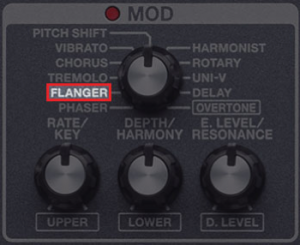 MODULATION
MODULATION
Modulation effects (like phaser and flanger) follow effects like wah and overdrive. This allows the modulation effect to process and modify the tone built by the effects before it. If you put a modulation effect before the overdrive, then you are overdriving the sound of the flanger. This is a lot more difficult to control so the ME-80 places it after these effects. EQUALIZER
Equalizers are used to shape tone, they boost or cut different frequencies and are great for making sure your guitar tone meshes well with other instruments. The ME-80 places the Equalizer effect after the flanger. This allows the EQ to shape the final tone before it hits any ambience effects.


 DELAY/REVERB
DELAY/REVERB
